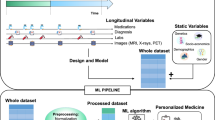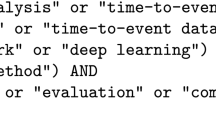Abstract
In many studies, sequence of events may occur over time that produce repeated measures with censored observations. Multi-state models are commonly used, and the effect of risk factors on the transition from one state to another is assessed using the Cox proportional hazards model. In recent years, there is growing interest to predict the disease status at different stages and endpoints using multi-state models. Because of the complexity of existing methods their applications for prediction is limited. In this paper, a simple alternative method is proposed for risk prediction of the sequence of events using multistage modelling approach. The proposed method of prediction is a new development using a series of events in conditional setting arising from the beginning to the endpoint. The proposed method is based on marginal-conditional approach to link the events occurring in a trajectory. The probability of a trajectory can be calculated easily. The main improvement of proposed method for risk prediction is that it is a simple approach, compared to the existing ones, and this approach can easily be generalized to any number of events in the process to the endpoints. Two examples from real life data is illustrated in this paper using the proposed method for risk prediction.
















Similar content being viewed by others
References
Aalen OO, Borgan O, Gjessing HK (2008) Survival and event history analysis: a process point of view. Springer Science+Business Media, LLC, New York
Andersen PK (2002) Competing risks as a multi-state model. Stat Methods Med Res 11:203–215
Andersen PK, Hensen LS, Keiding N (1991) Non- and semi- parametric estimation of transition probabilities from censored observation of a non-homogeneous markov process. Scand J Stat 18:153–167
Andersen PK, Perme MP (2008) Inference for outcome probabilities in multi-state models. Stat Methods Med Res 11:91–115
Arjas E, Eerola M (1993) On predictive causality in longitudinal studies. J Stat Plan Inference 34:361–368
Arriagada R, Rutqvist LE, Kramar A (1992) Competing risks de- termining event-free survival in early breast cancer. Br J Cancer 66:951–957
Beyersmann J, Schumacher M, Allignol A (2012) Competing risks and multistate models with r. Springer, New York
Boracchi P, Antolini L, Biganzoli E, Marubini E (2005) Competing risks: modelling crude cumulative incidence functions. Statistica Applicata 17:25–60
Commenges D (1999) Multi-state models in epidemiology. Lifetime Data Anal 5:315–327
Cox DR (1972) Regression models and life tables (with discussion). J R Stat Soc B 34:187–220
Dabrowska DM, Sun G, Horowitz MM (1994) Cox regression in a Markov renewal model: an application to the analysis of bone marrow transplant data. J Am Stat Assoc 89:867–877
Farewell VT (1979) An application of Cox’s proportional hazard model to multiple infection data. Appl Stat 28:136–143
Fine JP, Gray RJ (1999) A proportional hazards model for the subdistribution of a competing risk. J Am Stat Assoc 94:496–509
Gail MA (1975) A review and critique of some models used in competing risk analysis. Biometrics 31:209–222
Gillam MH, Ryan P, Graves SE, Miller LN, de Steiger RN, Salter A (2010) Competing risks survival analysis applied to data from the australian orthopaedic association national joint replacement registry. Acta Orthop 81:548–555
Gray RJ (1988) A class of K-sample tests for comparing the cumulative incidence of a competing risk. Ann Stat 16:1141–1154
Holt JD (1978) Competing risk analyses with special reference to matched pair experiments. Biometrika 65:159–165
Hougaard P (1999) Multi-state models: a review. Lifetime Data Anal 5:239–264
Islam MA (1994) Multistate survival models for transitions and reverse transitions: an application to contraceptive use data. J Royal Stat Soc Ser A 157:441–455
Islam MA, Chowdhury RI (2017) Analysis of repeated measures data. Springer, Singapore
Islam MA, Chowdhury RI, Chakraborty N, Bari W (2004) A multistage model for maternal morbidity during antenatal, delivery and postpartum periods. Stat Med 23:137–158
Kalbfleisch JD, Prentice RL (1980) The statistical analysis of failure time data. Wiley, New York
Kaplan EL, Meier P (1958) Nonparametric estimation from incomplete observations. J Am Stat Assoc 53:457–481
Kay R (1982) The analysis of transition times in multistate stochastic processes using proportional hazard regression models. Commun Stat 11:1743–1756
Klein JP, Keiding N, Copelan EA (1994) Plotting sumary predictions in multistate survival models: probabilities of relapse and death in remission for bone marrow transplantation patients. Stat Med 13:2315–2332
Klein JP, Moeschberger ML (2003) Survival analysis: techniques for censored and truncated data. Springer, New York
Kleinbaum DG, Klein M (2012) Survival analysis: a self-learling text. Springer, New York
Lunn M, Cole SR, Gange SJ (2009) Competing risk regression models for epidemiologic data. Am J Epidemiol 170:244–256
Meira-Machado L, Una-Alvarez J, Cadarso-Suarez C, Andersen PK (2009) Multi-state models for the analysis of time-to-event data. Stat Methods Med Res 18:195–222
Moreira A, Meira-Machado L (2012) survivalbiv: estimation of the bivariate distribution function for sequentially ordered events under univariate censoring. J Stat Softw 46:1–16
Porta N, Gomez G, Calle M L, Maltas N (2007) Competing risks methods. https://upcommons.upc.edu/bitstream/handle/2117/2201/TRCR.pdf. Accessed 20 Jan 2019
Prentice RL, Kalbfleisch JD, Peterson AV, Flournoy N, Farewell VT, Breslow NE (1978) The analysis of failure times in the presence of competing risks. Biometrics 34:541–554
Putter H (2011) Tutorial in biostatistics: Competing risks and multistate models analyses using the mstate package. http://cran.rproject.org/web/packages/mstate/vignettes/Tutorial.pdf
Putter H, Fiocco M, Geskus RB (2007) Tutorial in biostatistics: competing risks and multi-state models. Stat Med 26:2389–2430
Putter H, van der Hage J, de Bock GH, Elgalta R, van de Velde CJH (2006) Estimation and prediction in a multi-state model for breast cancer. Biom J 3:366–380
Satagopan JM, Ben-Porat L, Berwick M, Kutler D, Auerbach AD (2004) A note on competing risks in survival data analysis. Br J Cancer 91:1229–1235
Tai BC, Machin D, White I, Gebski V (2001) Competing risks analysis of patients with osteosarcoma: a comparison of four different approaches. Stat Med 20:661–684
Acknowledgements
We acknowledge gratefully that this study is supported by the HEQEP subproject 3293 of the University Grants Commission of Bangladesh and the World Bank. We also acknowledge the permission of Dr. Halida Hanum Akhter, Director, BIRPERHT, for using the data in the second example in this paper. The authors would like to thank Mahbub E Elahi K. Chowdhury and Arindom Sen, BIRPERHT for their assistance during different phases of this work. The authors are greatly indebted to the Ford Foundation for funding the data collection of the maternal morbidity study.
Author information
Authors and Affiliations
Corresponding author
Additional information
Publisher's Note
Springer Nature remains neutral with regard to jurisdictional claims in published maps and institutional affiliations.
Rights and permissions
About this article
Cite this article
Chowdhury, R.I., Islam, M.A. Prediction of risks of sequence of events using multistage proportional hazards model: a marginal-conditional modelling approach. Stat Methods Appl 29, 141–171 (2020). https://doi.org/10.1007/s10260-019-00460-2
Accepted:
Published:
Issue Date:
DOI: https://doi.org/10.1007/s10260-019-00460-2




